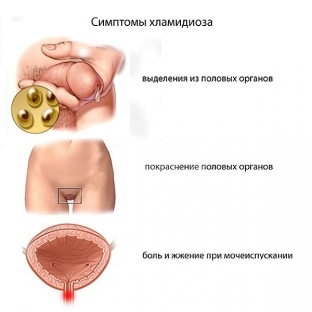Urogenital chlamydia is one of those special sexually transmitted infections that do not give preference to men or women, the elderly or adolescents, do not hide in the body for years and do not become a topic for discussion with a venereologist. Chlamydia develops a couple of weeks after infection, gives fairly distinct symptoms, if you look at them correctly, and causes serious inflammation in the genitourinary system. Chlamydia in men most often becomes a field of activity for a urologist, because without timely and well-chosen treatment, patients get complications in this area.
What are the symptoms of chlamydia infection in men
According to experts, today the problem of the prevalence of chlamydia is very acute, every year in the world such a number of new applications of patients with signs of chlamydia infection are recorded that this disease is confidently put forward on the first positions of the list of sexually transmitted infections. Perhaps the reason for this is the early onset of sexual relations in many countries, when adolescents are not yet concerned about the safety of sex. Another reason may be the ability of the chlamydia pathogen to combine with other pathogens - such as fungus, Trichomonas, gonococci - and due to them give a fuzzy picture of infection, misleading doctors.
After penetration into the human body (usually this occurs during sexual intercourse by any method), chlamydia invades the cells of the mucous membrane and may not be active for quite a long time. As soon as the body's defenses weaken for some reason, chlamydia become active and begin to multiply rapidly.
It should be noted that chlamydia in men occurs in about half of the cases with virtually no symptoms that could force the patient to urgently go to the doctor with questions. Unfortunately, with such an indistinct form of the disease, it is potentially dangerous for sexual partners, since it is able to infect them with chlamydia without knowing it. In addition, the asymptomatic development of the disease is fraught with serious complications due to the fact that the infection was not stopped in a timely manner.
Most often, chlamydia in men makes the patient come to the urologist with such complaints about his own health:
- burning and pain when urinating;
- itching around the penis;
- hyperemia and edema in the area of the outlet of the urethra;
- discharge from the urethra (watery, but may be purulent-mucous).
This phase of chlamydia in men is considered acute, and treatment started at this time will be quite effective. But if the patient did not find time to visit the doctor with his complaints, then the symptoms soon subside, the clinical manifestations disappear. Unfortunately, this does not mean a self-healing of chlamydia, but the transition of the disease to a chronic form.

Chronic form and complications of chlamydia in men
Without proper treatment, hamidia infection rises up the genitourinary system, covering the prostate gland, testicles, urethra, and urinary tract with inflammation. The disease can cover, in addition to the genitourinary system, the rectum, kidneys, affect the joints, cause chlamydial conjunctivitis and inflammatory processes in the broncho-pulmonary system.
The most serious complications of chlamydia in men, if we consider the urogenital area, are prostatitis, inflammation of the epididymis or urethritis. These inflammatory processes can cause male infertility.
Prostatitis caused by chlamydia can be suspected by pain in the lumbar region, in the perineum, in the rectal area, which develop against the background of impaired potency. Inflammation is manifested by mucous discharge from the urethra and difficulty urinating.
Chlamydial urethritis can be assumed when the patient complains of painful and frequent urge to urinate, as well as itching in the urethra and purulent discharge from it.
Epididymitis is clearly visible with swelling and severe inflammation of the scrotum, while the patient develops a high temperature, the skin in the scrotum area is bright red, the epididymis is enlarged.
Features and approaches to the treatment of chlamydia in men
A feature of the treatment of chlamydia in men is the individual selection of a treatment regimen, since the specificity of the pathogen does not allow the use of standard treatment algorithms. Antibiotics of those groups are selected that are able to penetrate the cell membrane and infect chlamydia (for example, macrolides or tetracyclines), and also can properly act on infections accompanying chlamydia and neutralize them too.
Thus, chlamydia in men requires timely initiation of treatment, a well-chosen regimen of therapy and scrupulous adherence by the patient to medical recommendations, which will help reduce the risk of developing severe complications after this infection.








Add a comment